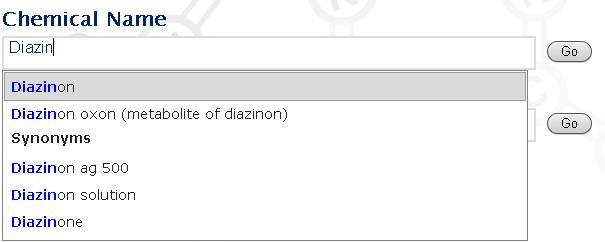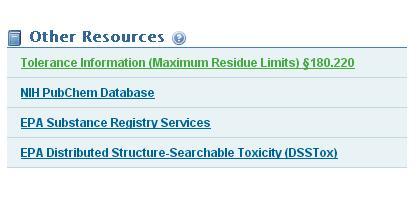Indexes to Part 180 Tolerance Information for Pesticide Chemicals in Food and Feed Commodities
This Web page describes information that may be helpful in finding specific pesticide tolerance information available in the Code of Federal Regulations (CFR) at Part 180. The pesticide tolerance information provided in the index pdf files below are intended to help registrants, scientists, importers, trade associations and extension agents identify:
- Tolerances (maximum residue levels) or exemptions from tolerance requirements for a food or feed commodity.
- Pesticide chemicals that belong to a particular commodity, crop group or crop subgroup.
- Pesticide chemicals that belong to a particular pesticide type or pesticide family.
Note: Pesticide tolerance information is updated in the Code of Federal Regulations on a yearly basis. EPA plans to update the index files on this Web page as needed. These index files are current as of the date indicated in the file. For the latest information on pesticide tolerances, please refer to the electronic Code of Federal Regulations (eCFR).
How to Use Pesticides Chemical Search to Find Chemicals by Pesticide Common Name
Chemical Search is designed for searching by simply typing in the name of the chemical or active ingredient of interest. Once on a page for a specific chemical or active ingredient, users can explore the tabs arranged across the top of the page for more detailed information.
Information that can be found through Pesticide Chemical Search includes:
- Pesticide common name.
- Section in 40 CFR part 180 with detailed tolerance information.
- Whether a tolerance or an exemption has been set.
- Chemical Abstract Service (CAS) registry number.
- CAS index name.
- Pesticide type.
- Pesticide family.
- EPA PC code.
An Example Illustrating How to Use this Index
For example, you are looking for the pesticide "Diazinon" tolerance information. Using Pesticide Chemical Search, you can go the Chemical Search page and search the "Pesticide Common Name" for "Diazinon" in the Chemical Name field. As you type, you may see multiple entries for this pesticide.

Select the chemical to open its Chemical Search information page. Navigate to the area titled "Other Resources," where you will find a link to your chemical's tolerance information.

Learn more about Pesticide Chemical Search.
General Information about Pesticide Chemicals by Pesticide Type and Family
The information in this index is listed alphabetically for pesticide chemicals by pesticide type and family. The index provides the following information:
- Pesticide type.
- Pesticide family.
- Pesticide common name.
- Section in 40 CFR part 180 with detailed tolerance information.
- CAS registry number.
- EPA PC code.
How do I search for a pesticide type or family in this index?
An Example Illustrating How to Use this Index
For example, you are looking for a pesticide in the sulfate ester family that belongs to the acaricide type. Using the table below, you would search the "Pesticide Type" column for "acaricide" and continue down the "Pesticide Family" column until you found pesticide family "sulfite ester" You would see that there is one entry for this pesticide type and family.
| 40 CFR | Type | Family | Common Name | CAS Number | PC Code |
|---|---|---|---|---|---|
| 180.163 | Acaricide | Bridged diphenyl | Dicofol (1,1-Bis(chlorophenly)-2,2,2-trichloroethanol) | 115-32-2 | 010501 |
| 180.198 | Acaricide | phosphonate | Trichlorfon | 52-68-6 | 057901 |
| 180.259 | Acaricide | sulfite ester | Propargite | 2312-35-8 | 097601 |
| 180.446 | Acaricide | tetrazine | Clofentezine | 115-24-5 | 125501 |
| 180.448 | Acaricide | thiazolidine | Hexythiazox | 78587-05-0 | 128849 |
Tolerance-Specific Information about Pesticide Chemicals and Crop Groups by Commodity, Crop Group or Crop Subgroup
The information provided in this index is listed alphabetically by commodity, crop group or crop subgroup, and provides the following information:
- Commodity, crop group, crop subgroup.
- Pesticide common name.
- Tolerance in parts per million (ppm).
- Section in 40 CFR part 180 with detailed tolerance information.
- CAS registry number.
- EPA PC Code.
How do I search for a commodity, crop group, or crop subgroup in this index?
- Open the Tolerances by Commodity, Crop Group, or Crop Subgroup Index
- Instructions on how to search a PDF document.
An Example Illustrating How to Use this Index
For example, you are looking for the tolerance information on buckwheat used as grain, you would search the “Commodity, Crop Group, Crop Subgroup” column for “Buckwheat, grain," the preferred EPA commodity term. You would see that there is one entry for this commodity.
| Commodity, Crop Group, Crop Subgroup | Pesticide Common Name | Parts Per Million (PPM) | 40 CFR Section | Chemical Abstract Service (CAS) Number | EPA PC Code |
|---|---|---|---|---|---|
| Buckwheat, flour | Sethoxydim | 25 | 180.412 | 74051-80-2 | 121001 |
| Buckwheat, fodder | Glufosinate ammonium | 0.40 | 180.473 | 51276-47-2, 53369-07-6 | 128850 |
| Buckwheat, forage | Glufosinate ammonium | 0.40 | 180.473 | 51276-47-2, 53369-07-6 | 128850 |
| Buckwheat, grain | Sethoxydim | 19 | 180.412 | 74051-80-2 | 121001 |
Background Information
Commodities, Crop Groups, and Crop Subgroups
- A commodity is any unprocessed or partially processed good, such as grains, fruits and vegetables.
- For tolerance purposes, a crop group is a group of crops that are botanically or taxonomically related. Tolerances for a crop group are based on residue data from representative crops (normally major crops) within the group.
- A crop group may be further subdivided into crop subgroups; these are smaller and more closely related crop groupings. The representative commodities for each subgroup are also a smaller subset of those for the “parent” group.
Pesticide Types and Families
Pesticides are often categorized based on the type of pest they control. For example, the pesticide type "herbicides" kill weeds and other plants that grow where they are not wanted. Pesticides are also categorized by the chemical family to which they belong; these families are based on similarities in chemical structures, modes of action and chemical properties. For example, malathion, parathion and phosalone belong to the pesticide family "organophosphorus."
Title 40 of the Code of Federal Regulations
When viewing these index files, you will be directed to the detailed pesticide tolerance information in Title 40 of the Code of Federal Regulations (40 CFR). The detailed information for each pesticide residue and its metabolites includes:
- Tolerances for different agricultural commodities.
- Time-limited tolerances (such as Section 18 exemptions).
- Tolerances with regional limitations.
- Indirect or inadvertent residues.
